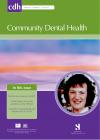Community Dental Health

- Cover Date:
- June 2012
- Print ISSN:
- 0265 539X
- Vol:
- 29
- Issue:
- 2
Clinical evaluation of three caries removal approaches in primary teeth: A randomised controlled trial
Objective: To evaluate the clinical performance and radiographic outcome of glass ionomer cement (GIC) restoration in primary molars using three caries removal techniques. Basic research design: Randomised clinical controlled trial. Clinical setting: Two standard dental clinics in 2 hospitals near Bangkok. Participants: A total of 276 children, aged 6-11, having dentinal caries on the occlusal and/or proximal surface extending at least one-third of dentine without signs and/or symptoms of irreversible pulpitis. Intervention: Children were randomly allocated into 3 study groups with different caries removal techniques: Group 1, partial soft caries removal at enamel-dentine junction (EDJ) by spoon excavation; Group 2, complete soft caries removal by spoon excavation; and Group 3, conventional caries removal by steel burs. All cavity preparations were restored with GIC (Fuji IX, GC Corp., Japan). Main outcome measures: Clinical and radiographic evaluations were carried out at 6 and 12 months after restoration. Results: After 12 months, 89, 89, and 88 restorations in Groups 1, 2 and 3 were evaluated. The cumulative survival rates of GIC restorations in Groups 1, 2 and 3 were 83%, 83%, and 89% while the cumulative survival rates of pulp were 99%, 100% and 98% respectively. There were no statistically significant differences in the survival of GIC restorations or pulp in the three groups (p>0.05). Conclusion: The clinical and radiographic evaluations after 12 months indicated that partial soft caries removal at EDJ followed by GIC restoration was comparable to that of ART and conventional approaches.
Key words: partial caries removal, minimal intervention, ART, survival
- Article Price
- £15.00
- Institution Article Price
- £
- Page Start
- 173
- Page End
- 178
- Authors
- A. Phonghanyudh, P. Phantumvanit, Y. Songpaisan, P.E. Petersen
Articles from this issue
- Title
- Pg. Start
- Pg. End
- Dental Public Health in Action - The Platform for Better Oral Health in Europe Report of a New Initiative
- 131
- 133
- Effect of national recommendations on the sale of sweet products in the upper level of Finnish comprehensive schools
- 149
- 153
- A review of strategies to stimulate dental professionals to integrate smoking cessation interventions into primary care
- 154
- 161
- When Can Oral Health Education Begin? Relative effectiveness of three oral health education strategies starting pre-partum
- 161
- 167
- Clinical evaluation of three caries removal approaches in primary teeth: A randomised controlled trial
- 173
- 178
- Relationship between gingivitis severity, caries experience and orthodontic anomalies in 13-15 year-old adolescents in Brno, Czech Republic
- 179
- 183
- Prevalence of necrotizing ulcerative gingivitis and associated factors in Koranic boarding schools in Senegal
- 184
- 187
